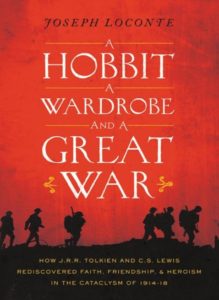This review of Joseph Loconte’s A Hobbit, a Wardrobe, and a Great War—which looks at C.S. Lewis and J.R.R. Tolkien’s experiences in World War I—first appeared in the Fall 2018 issue of Providence’s print edition. To read the original in a PDF format, click here. To receive complete copies of future issues as soon as they are published, be sure to subscribe here.
Arguably, there would be fewer Christians today if not for the works of C.S. Lewis, including The Chronicles of Narnia series. And novels by J.R.R. Tolkien, a Catholic who helped convert his atheist friend Lewis to Christianity while they both taught at Oxford University, have resonated across society for decades. Many have suggested that J.K. Rowling, who grew up Anglican and is now a member of the Church of Scotland (i.e., Presbyterian), borrowed heavily from Tolkien’s Lord of the Rings series and The Hobbit in her Harry Potter series. One reviewer online at IMDB even blasted Tolkien because he “kind of rips off Harry Potter in many ways.”
 While Lewis and Tolkien’s faith and contributions are well-known, most do not realize they both fought in the First World War as young men. Even fewer recognize how their time in the western front’s trenches influenced their faith and later works. However, in A Hobbit, A Wardrobe, and a Great War, Providence senior editor Joseph Loconte explains in his typical, approachable prose how the war affected these two men deeply and how those experiences influenced their writings and faith. Whether someone is interested in the war’s history, the writer’s books, or Christian realist perspectives on war, reading Loconte’s work is more than worthwhile. This book also offers the church lessons for today.
While Lewis and Tolkien’s faith and contributions are well-known, most do not realize they both fought in the First World War as young men. Even fewer recognize how their time in the western front’s trenches influenced their faith and later works. However, in A Hobbit, A Wardrobe, and a Great War, Providence senior editor Joseph Loconte explains in his typical, approachable prose how the war affected these two men deeply and how those experiences influenced their writings and faith. Whether someone is interested in the war’s history, the writer’s books, or Christian realist perspectives on war, reading Loconte’s work is more than worthwhile. This book also offers the church lessons for today.
When he was 24 years old, Tolkien deployed to France in 1916 as a second lieutenant in the British Expeditionary Force (BEF) that fought in the Battle of the Somme, where there would be over 1.3 million casualties. Loconte recounts some of Tolkien’s most hellish days in the trenches, including when his unit assaulted the German-held village Ovillers-la-Boisselle. As this book convincingly argues, the Somme helped inspire fictional battles in The Lord of the Rings and other works. For instance, Tolkien’s description for the Siege of Gondor looks eerily like the western front’s No Man’s Land, including this line: “All before the walls on either side of the Gate the ground was choked with wreck and with bodies of the slain; yet still driven as by a madness more and more came up.” No one should be surprised these fictional war scenes resemble World War I. “Indeed,” Loconte writes, “it would be remarkable if the destruction Tolkien witnessed along the western front did not find expression in his creative works.”
Beyond the war’s physical landscape and mass destruction, the soldiers Tolkien fought alongside also seem to make appearances in his works. Loconte demonstrates how hobbits like Sam Gamgee have many similarities with the regular “citizen soldiers” in the BEF. While England’s military leaders made blunders, thousands upon thousands of ordinary British men made the routine sacrifices and did the seemingly small work that led their country to victory. “Like the soldiers in that war,” Loconte explains, “the homely hobbits could not have perceived how the fate of nations depended upon their stubborn devotion to duty.”
Around the time Tolkien contracted “trench fever” and so left the battlefield, C.S. Lewis deployed in November 1917 with the BEF to the western front while he was still an atheist. Like Tolkien, he spent months in the trenches and lost his close friends in combat, and he also assaulted another German-held village, Riez du Vinage. While Lewis’ regiment took this location in 45 minutes, the next morning the Germans counterattacked. A mortar shell, probably from British friendly fire, exploded near Lewis and killed a sergeant. Though only wounded, a shell fragment lodged into his body so close to his heart that doctors couldn’t remove it safely, so Lewis carried it with him for the rest of his life. Experiences with war’s reality like this later influenced his writing, such as in the Narnia series. As Loconte shows, Lewis used his war experiences “as a guidepost to moral clarity” without accepting utopianism or cynicism.
The combination of moral clarity, heroism, and realistic Christian hope in Lewis’ and Tolkien’s works contrasts sharply with the widespread cynicism in Western societies after World War I devastated earlier beliefs. Loconte notes how before the war the overly optimistic “Myth of Progress” had lulled the West into believing it could perfect itself through science, rationality, and other means, so devastating wars had become obsolete. But realities proved this myth false, causing pervasive hopelessness. Many other veterans from the war, including Ernest Hemingway and T.S. Eliot, reflect this disillusionment in their writings.
Meanwhile, during the war churches on both sides portrayed their countries’ participation as a divine necessity. Loconte shows how this “Christian nationalism” inspired English clergy to show the war as a war between Christianity and paganism, while the German clergy preached that their nation was serving a messianic role. But soldiers in the trenches showed little appreciation for this interpretation, and many went on to reject Christian faith.
So Tolkien and Lewis rejecting their generation’s cynicism and disillusionment while promoting a Christian realism without utopianism is rare and worth studying. As Loconte demonstrates multiple times throughout his book, war ultimately strengthened their spirituality and belief in heroism, which many others considered antiquated. Both believed that “war could inspire noble sacrifice for humane purposes,” and they provide a tortured world Christian hope. Yet the two offer this hope while recognizing humanity’s sinfulness. Far from being perfect and triumphant heroes on a crusade, their protagonists are often flawed. And it is these sinful characters who fight necessary and just battles against evil. While their works’ mythical nature looks escapist, Loconte persuasively argues how their characters’ flaws make them far more real, and time on the western front gave Lewis and Tolkien the perspective and empathy to create such stories. “It can be argued,” Loconte writes, “that these epic tales—involving the sorrows and triumphs of war—could never have been written had these authors not been flung into the crucible of combat.”
An unspoken warning to the church today lies within A Hobbit, A Wardrobe, and a Great War. Many Americans have come to assume that devastating war is obsolete, or at least they can’t comprehend the amount of death such a war would create. Technologically advanced weapons like stealth fighters, precision munitions, and unmanned aerial vehicles have allowed the US to fight wars with relatively few casualties, especially when fighting low-tech terrorists. But near-peer adversaries like Russia and China are narrowing the technology gap and preparing for “asymmetric warfare,” which puts American servicemembers at risk. Even if our technology remains better in all domains of warfare, this advantage doesn’t guarantee victory, just as superior German tanks in World War II didn’t guarantee victory against cheaper, mass-produced American tanks. The US could assume that the threat of nuclear weapons means a geopolitical accident, like what happened in Sarajevo in 1914 to start the Great War, is unlikely (perhaps this assumption is unwise, given how Loconte demonstrates that WWI proved the Myth of Progress horrifically wrong). Yet our adversaries sell many of their advanced weapons, like the Russian S-400 missile battery that has been called an “F-35 killer” (referencing America’s new stealth fighter), to other countries and groups that may threaten the United States. Even the Houthi rebels in Yemen acquired anti-ship and ballistic missiles from Iran. This ragtag army then fired on US Navy ships in the Red Sea, and it even struck Emirati naval ships, including one built in 2003 that had been part of our Navy. The US military can manage threats like these for now because of its technological advantage, and may be able to do so for a while if given proper funding. But as more enemies and adversaries acquire better and cheaper military technology, America’s advantage will decrease so that when we must deploy troops, such a war may cause casualties the US has not endured in decades.
If Loconte is right that the Myth of Progress is wrong, then mankind cannot perfect itself and devastating, mass-casualty wars can still happen. If the United States must deploy its military and suffer heavy casualties, a cynicism and disillusionment similar to what Western societies suffered after the Great War may envelop America.
The church is likely unprepared for such a war. In the same way that, as Loconte recounts, most Anglican chaplains stayed far from the frontlines in World War I and therefore could not relate to soldiers in the trenches, today’s American clergy and laypeople have mostly not served and don’t understand military life. Pastors may not be prepared to handle the hopelessness in their pews if America experiences a mass-casualty war, so a first step for the church would be to understand military life better.
A second step for churches and clergy could be to read or reread the stories of C.S. Lewis and J.R.R. Tolkien, alongside Loconte’s book, to learn how even flawed people can be called to fight heroically for just causes. Knowing what these English authors experienced in battle while reading their works adds more authenticity and legitimacy to their words and advice about fighting and war. Often the best comfort and wisdom come from those who have already endured tragedy, so Tolkien and Lewis can comfort readers going through hell because they’ve been through hell, too.
Mark Melton is Providence’s deputy editor. He is a Mississippian who lives in Virginia and graduated with his master’s in international relations from the University of St. Andrews, Scotland.
Photo Credit: Staged photograph of a Canadian battalion going “over the top” during World War I, 1918. Source: National Library of Scotland.






